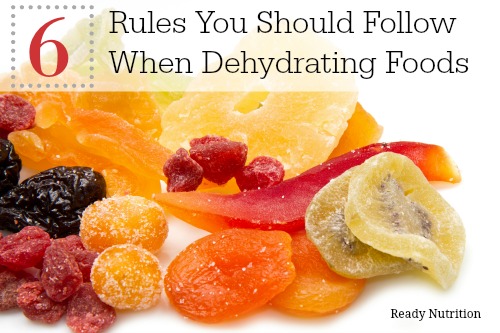
- dry vegetables for soup mixes
- dry fruits for snacking
- make jerky
- fruit or vegetable leather
- noodles
- and even make crafts
Before you go crazy dehydrating, keep in mind that there are a few rules to follow to ensure food longevity, freshness and prevention of discoloration.
6 Rules You Need To Follow When Dehydrating Foods
- You can dehydrate any fruit or vegetable, regardless of quality or ripeness. If something is too ripe and soft, you can always puree it and dry the puree. Although using the best quality fruits and veggies will result in the best quality dried goods, remember that the goal here is preservation, not perfection. So don’t be afraid to dehydrate the bruised, overripe, and slightly damaged goods. Just make sure not to put mold in the dehydrator as it can spread and infect the rest of the foods.
- Some food items can be air-dried. Herbs and other green leafy food sources, in particular, do not necessarily need a dehydrator. They can be set out of the way and air-dried.
- Some foods need to be blanched. Blanching certain foods like onions, mushrooms and tomatoes ahead of time will limit discoloration and the risk of food-borne illnesses. This isn’t necessary, but it certainly helps in the longevity of your dried foods.
- Cook potatoes thoroughly for further enjoyment. Potatoes, beans and other root vegetables should be cooked thoroughly and then dehydrated. I’ve made a pot of beans and dehydrated them for soups. I have also made dehydrated potato flakes to use in my prepper pantry.
- Don’t dehydrate foods from different families at the same time. If you are dehydrating foods from different family groups, the flavors can cross over. For instance, if you are dehydrating tomatoes and peppers, note that the tomatoes will end up being spicy. As well, any Brassica should be dehydrated on its own, otherwise the sulfur taste will permeate into the other foods. The only exception is dehydrating fruits. Fruits can be mixed together, but mixing them with strong-tasting or smelling vegetables is not recommended.
- Be consistent with your cut size and spacing. Try to keep the slices of food the same thickness to encourage even drying times. As well, try not to allow the food to touch one another or overlap (green leafy vegetables are ok though). Otherwise, it can block the airflow and prevent drying.
Rehydrating Your Dried Food Sources
Rehydrating your dehydrated foods requires nothing more than the food to be introduced to a liquid. Get creative with the liquid that you use like juices, canning liquids, etc. Many preppers have found that rehydrating foods in liquids other than water gives the food a richer taste. For instance, soaking fruit in fruit juice makes rehydrated fruit taste sweeter or soaking textured vegetable protien (TVP) in meat stock helps give it a richer flavor.
Dehydrating foods is an excellent way to make use of food you have around you. Typically, at my home when the fruit bowl is overlooked, I will dehydrate fruits and create a healthy snack that the kids can’t resist. I also have made dried soups with the extra vegetables in the refrigerator.
For more information read, Drying Fruits and Vegetables by the University of Georgia
This article was originally published at Ready Nutrition™ on February 9th, 2017







If you are serious about dehydrating (which I highly recommend) just go for it and get the Excalibur with 10 trays. The bad part about the little round dehydrators that you can get at farm stores or WalMart is getting the food OFF of the trays. Frustrating, to say the least. The Excalibur has trays with a non-stick mat, and no matter what you dehydrate, you can peel it off in one piece no matter if it is jerky, strawberries, tomatoes, or, my favorite, dehydrated cantaloupe.
I dehydrated tomatoes…three yrs. ago and life…happened. Now, are these tomatoes still eatable?? Kind of smell unusual…not really bad..but I don’t know how they should really SMELL??? Three qts. of them. Help!!